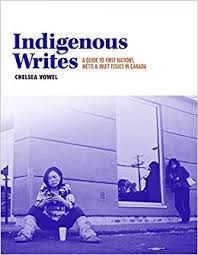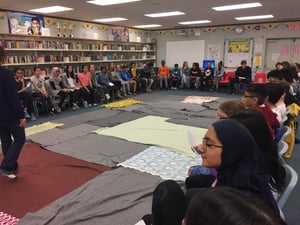How do I promote equity and inspire social justice as an educator when I’m not in a social studies or humanities classroom - or in a classroom at all? This was the question that both shifted and drove new passion into my work this past year as an Instructional Coach. Stepping out of the classroom this year was a transition. I was really missing the opportunity to inspire equity and social justice as I had in my classroom. As teachers requested my support, most often with math, I found myself starving for activism and ways to get involved in equity and inclusion beyond academic instruction. Then I went to a meeting that shifted my thinking, and gave me new insight into how I could continue to pursue equity and social justice no matter what the subject.
My Aha Moment: Realizing Education for Reconciliation Can Happen Anywhere
At the beginning of meetings, announcements, and presentations, my school board includes a land acknowledgement in support of the Truth and Reconciliation Calls to Action #62 and #63. Often the presenter demonstrates discomfort with regards to how to address the land acknowledgement. I have also felt the discomfort of those around me who really did not know what they should be reflecting on at this time. During one of these meetings I realized I could help. The previous year I had been given the opportunity to be a part of my school board's First Nation, Metis, and Inuit Strategic Action Plan (SAP), where I was given many opportunities to learn and unlearn Indigenous History and present day realities. We participated in Cycle One and Cycle Two: Indigenous Cultural Competency Training, and Cycle Three Treaties with the OFIFC. We visited the Woodland Cultural Center to learn from the staff and Residential School survivors, Metis elders, read “Indigenous Writes” by Chelsea Vowel and much more.

As a non-Indigenous person I continue to be in a learning stance, but I thought I could share what I was learning in connection to the meeting land acknowledgement. I offered this to my superintendent and he agreed. For the next couple of months, I spoke to the land acknowledgement at our Family of Schools monthly meetings. I spoke about the different symbols in the land acknowledgement, who was involved in deciding on the land acknowledgement, Indigenous terms, Indigenous names, and resources. The feedback was very positive and many administrators requested my talking points so they could share them with their staff during their school meetings.
 I realized with a little intentionality I could continue to bring an equity lens to students through my planning with teachers and my contact with administrators in this leadership position. I also realized that I could be a resource to my fellow Instructional Coaches who did not have the learning opportunities I have had: attending ministry workshops regarding the new social studies curriculum, attending Facing History’s Stolen Lives: Indigenous Peoples of Canada and Indian Residential Schools, summer seminar, and learning with Kim Wheatley, an Anishinaabe Traditional Grandmother and band member of Shawanaga First Nation. Again the feedback was positive and the questions kept coming.
I realized with a little intentionality I could continue to bring an equity lens to students through my planning with teachers and my contact with administrators in this leadership position. I also realized that I could be a resource to my fellow Instructional Coaches who did not have the learning opportunities I have had: attending ministry workshops regarding the new social studies curriculum, attending Facing History’s Stolen Lives: Indigenous Peoples of Canada and Indian Residential Schools, summer seminar, and learning with Kim Wheatley, an Anishinaabe Traditional Grandmother and band member of Shawanaga First Nation. Again the feedback was positive and the questions kept coming.
I decided from that moment that I would also bring the lens of equity to every planning session I was invited to, even those focused on mathematics.
Reframing Mathematics and Social Studies Questions with a Reconciliation Lens
Though I was sometimes confronted with resistance, I found most teachers inspiring and ready to take on new learning once they knew where to start. A grade 7 teacher reframed his year long question or big idea to focus his teaching across the sciences, history and geography to be “How was Canada shaped by relationships?” We worked together to plan and teach an inquiry around the Royal Proclamation of 1763. A grade 8 class learned about the lack of access to clean drinking water on First Nation reserves and used this reality to ground an exploration of the different ways fluids can be transported, how to calculate volume of a cylinder, how water quality is tested, and create a system that will provide clean water to these regions.
From Individual Learning to Whole School Learning
Being a part of the SAP I was given the opportunity to become a facilitator of the Kairos Blanket Exercise. I offered to share this activity with an entire staff during a PD day and the principal jumped at the opportunity. Numerous classes at a middle school in my board have now shared in  the experience and had heartfelt discussions around discrimination, stereotypes, and the Canadian narrative through an Indigenous lens. Students shared feelings of disbelief and shared personal stories of coming to Canada to escape this treatment in their home country. Students led conversations about team logos and the negative stereotypes they perpetuate. The overwhelming feeling was that of feeling empowered to share this information with those around them. In the younger grades I have read Indigenous picture books, offered book list to school libraries, and provided texts to teachers for read-alouds and examples.
the experience and had heartfelt discussions around discrimination, stereotypes, and the Canadian narrative through an Indigenous lens. Students shared feelings of disbelief and shared personal stories of coming to Canada to escape this treatment in their home country. Students led conversations about team logos and the negative stereotypes they perpetuate. The overwhelming feeling was that of feeling empowered to share this information with those around them. In the younger grades I have read Indigenous picture books, offered book list to school libraries, and provided texts to teachers for read-alouds and examples.
There have been situations where the work has been slower than I would have liked but there are other situations where educators and students take this new learning and run with it. At the conclusion of an activity or lesson I always ask the students this question, “Now that you have this information what are you going to do with it?” Students are consistently empowered to spread awareness and share their new learning with people around them. It is a wonderful feeling to hear students starting the conversations that are so desperately needed.
If you are infusing equity and social justice into your work outside of a social science/humanities classroom, I’d love to hear what you’re trying.

